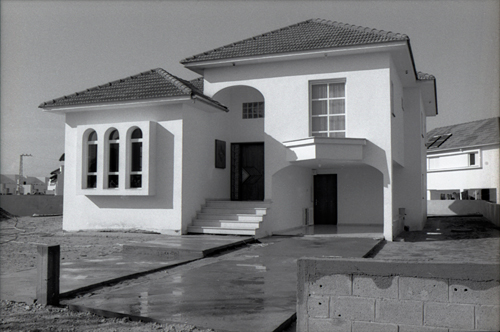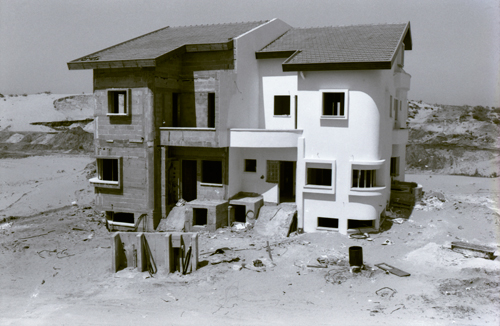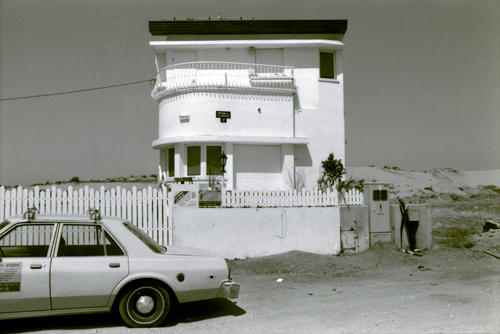| Emptied Walls and Constructed Landscapes | | | In the course of the past five years, Gilad Ophir has been obsessively occupied with the creation of an Israeli version of the contemporary “build your own home" ideal, manifested in the futuristic suburbia erected on the dunes of Holon, Rishon LeZion, Rechovot, Or Akiva, Giv’at Olga, as well as Shoham and Ma’ale Tivon. A photographic chronicle of a specific time and place. A documentation. This archive comprises two levels. The first one is concrete, visible; a storehouse of images in which the critical field - social, political, and aesthetic - is exposed. The second level is abstract and spiritual. Gideon Levy, in an article in the Ha’aretz newspaper touches upon critical points similar to those expressed by Ophir: “At the end of the day, the shoes are as dusty as after a month of reserve duty in the desert. The road to one of the great Israeli dreams still passes through sand dunes and rocky soil. Of course, it’s no longer a question of a pioneer enterprise - conquering the desert or draining the swamps. Not even a Zionist settlement project. Simply a house-and-garden, a duplex, penthouse, garden terrace, sun terrace, or at least with a preparation for air-conditioning, at a good location, preferably with a view of the sea, or at least of a prospective local country club which is bound to be built here, on a “Dutch-style” tiled alley, ten minutes drive from Tel Aviv, eight from Kfar Saba, or five from the center of Rishon LeZion.
Ophir’s unflattering Israeli archive reflects an outward-looking society, which adopts building styles belonging to other cultural traditions (France, Switzerland, Spain) and not always compatible with the local climate (such as sloping red tile roofs). These hybridized motifs of houses lacking proper architectural design are like an ironic fulfillment of the forgotten dreams of the pioneer settlers - a contemporary cultural absurdity. The constructions in the photographs look like emptied and prettified tombs (reminiscent of the megalomaniac aspect of ancient Egyptian tombs), like fortresses (“Village 1. no. 43, 1992”), or sanctuaries. These alienated constructions are replete with nouveau riche features – outsize dimensions, stylized fences, kitschy capitals. “Who buys them? You cannot define them as young couples, rather as people looking for better homes. People in the Dan region, say, who’re a little better off, who already have two cars.” The “compressing” of the houses on a small plot of land and the lack of space between them crush the urge of intimacy that lies behind the dream of a private house-and-garden, when that intimacy is imposed by walls, watchdogs, burglar alarms. The ridiculous billboards and pretentious names of the neighborhoods complement this surrealistic Israeli scenery, which attracts and repels Ophir at one and the same time.
For full text see the exhibition catalogue
| | | | For Gordon gallery web site | | |
| | | |  | | Gilad Ophir from the series Cyclopean Walls, Courtesy of the artist and Gordon Gallery | | |  | | Gilad Ophir from the series Cyclopean Walls | | |  | | Gilad Ophir from the series Cyclopean Walls, Courtesy of the artist and Gordon Gallery | | |
|